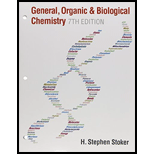
Concept explainers
(a)
Interpretation: The structures of the substances produced when the given disaccharide undergoes hydrolysis have to be drawn.
Concept introduction: During a hydrolysis reaction, the glycosidic linkage between the two monosaccharide units is the point of attack. Two monosaccharides are released by the cleavage of the glycosidic linkage during hydrolysis. The H-atom in water is supplied to one monosaccharide and an –OH group entity is supplied to the other monosaccharide.
(b)
Interpretation: The structures of the substances produced when the given disaccharide undergoes hydrolysis have to be drawn.
Concept introduction: During a hydrolysis reaction, the glycosidic linkage between the two monosaccharide units is the point of attack. Two monosaccharides are released by the cleavage of the glycosidic linkage during hydrolysis. The H-atom in water is supplied to one monosaccharide and an –OH group entity is supplied to the other monosaccharide.
(c)
Interpretation: The structures of the substances produced when the given disaccharide undergoes hydrolysis are to be drawn.
Concept introduction: During a hydrolysis reaction, the glycosidic linkage between the two monosaccharide units is the point of attack. Two monosaccharides are released by the cleavage of the glycosidic linkage during hydrolysis. The H-atom in water is supplied to one monosaccharide and an –OH group entity is supplied to the other monosaccharide.
(d)
Interpretation: The structures of the substances produced when the given disaccharide undergoes hydrolysis have to be drawn.
Concept introduction: During a hydrolysis reaction, the glycosidic linkage between the two monosaccharide units is the point of attack. Two monosaccharides are released by the cleavage of the glycosidic linkage during hydrolysis. The H-atom in water is supplied to one monosaccharide and an –OH group entity is supplied to the other monosaccharide.
Trending nowThis is a popular solution!

Chapter 18 Solutions
Bundle: General, Organic, and Biological Chemistry, 7th + OWLv2 Quick Prep for General Chemistry, 4 terms (24 months) Printed Access Card
- Consider the following statements: (1) The term sugar is a general designation for both monosaccharides and disaccharides. (2) The "penultimate carbon" in a monosaccharide is used to determine D- or L-configuration. (3) Sucrose is a reducing sugar and lactose is a nonreducing sugar. O Two of the three statements are true. All three statements are true. O Only one of the statements is true. None of the statements are true.arrow_forwardDraw the open form of the monosaccharides of digitoxin/digoxin?arrow_forwardWhat is the name of the non-reducing monosaccharide found in the disaccharide shown here?arrow_forward
- Lactose and maltose are reducing disaccharides, but sucrose is a nonreducing disaccharide. Explain.arrow_forwarddraw a fischer projection formula for the enantiomer of each of the following monosaccharides.arrow_forwardConstruct the two enantiomeric forms/structure of the following monosaccharides and designate the handedness of each using D, L system: a. Ribulosearrow_forward
- Write the reaction equation for the formation of sucrose, indicate the bonds that connect the monosaccharides in the disaccharide. Biological value of sucrose.arrow_forwardIdentify the monosaccharide represented by each of the following structures. Name each compound.arrow_forwardIdentify the component monosaccharides of each of the following compounds and describe the type of glycosidic linkage in each.arrow_forward
- A disaccharide that is found in dairy products can be formed by the two monosaccharides. Please draw the Haworth structure of this disaccharide and give the name of the glycosidic bond.arrow_forwardWhat is the carbohydrate classification for the product produced when each of the following undergoes complete hydrolysis?arrow_forwardConvert the following Haworth projections to a Fischer projection. Name the monosaccharides you have drawn. a) CH2OH b) CH2OH H H он H H Он H но H но но ÓH I Iarrow_forward
 Human Anatomy & Physiology (11th Edition)BiologyISBN:9780134580999Author:Elaine N. Marieb, Katja N. HoehnPublisher:PEARSON
Human Anatomy & Physiology (11th Edition)BiologyISBN:9780134580999Author:Elaine N. Marieb, Katja N. HoehnPublisher:PEARSON Biology 2eBiologyISBN:9781947172517Author:Matthew Douglas, Jung Choi, Mary Ann ClarkPublisher:OpenStax
Biology 2eBiologyISBN:9781947172517Author:Matthew Douglas, Jung Choi, Mary Ann ClarkPublisher:OpenStax Anatomy & PhysiologyBiologyISBN:9781259398629Author:McKinley, Michael P., O'loughlin, Valerie Dean, Bidle, Theresa StouterPublisher:Mcgraw Hill Education,
Anatomy & PhysiologyBiologyISBN:9781259398629Author:McKinley, Michael P., O'loughlin, Valerie Dean, Bidle, Theresa StouterPublisher:Mcgraw Hill Education, Molecular Biology of the Cell (Sixth Edition)BiologyISBN:9780815344322Author:Bruce Alberts, Alexander D. Johnson, Julian Lewis, David Morgan, Martin Raff, Keith Roberts, Peter WalterPublisher:W. W. Norton & Company
Molecular Biology of the Cell (Sixth Edition)BiologyISBN:9780815344322Author:Bruce Alberts, Alexander D. Johnson, Julian Lewis, David Morgan, Martin Raff, Keith Roberts, Peter WalterPublisher:W. W. Norton & Company Laboratory Manual For Human Anatomy & PhysiologyBiologyISBN:9781260159363Author:Martin, Terry R., Prentice-craver, CynthiaPublisher:McGraw-Hill Publishing Co.
Laboratory Manual For Human Anatomy & PhysiologyBiologyISBN:9781260159363Author:Martin, Terry R., Prentice-craver, CynthiaPublisher:McGraw-Hill Publishing Co. Inquiry Into Life (16th Edition)BiologyISBN:9781260231700Author:Sylvia S. Mader, Michael WindelspechtPublisher:McGraw Hill Education
Inquiry Into Life (16th Edition)BiologyISBN:9781260231700Author:Sylvia S. Mader, Michael WindelspechtPublisher:McGraw Hill Education





